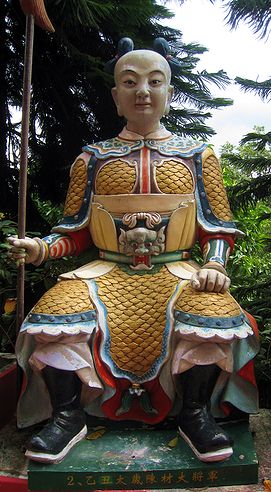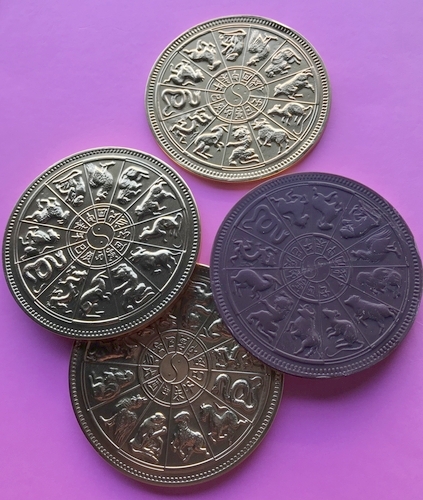
Content created: 1993-12-24
File last modified:

Chinese have traditionally made use of a specialized number system that counts from 1 to 60. The numbers in this system consist of a first character (or digit) from a series of ten "Heaven Stems" (tiāngān 天干) and the second from a series of twelve "Earth Branches" (dìzhī 地支). (In English, this is also called the "sexagenary cycle"; in Chinese, the gānzhī 干支)
Here is a list of the Chinese characters used, with their pronunciations. In our examples we will represent the ten Heaven Stems with upper case letters (A through J) and the twelve Earth Branches with lower case letters (a through l).
Cautionary note for students of Chinese: The Heaven Stem numbered F and called jǐ 己 (also used in the common word 自己) is not quite the same as the character yǐ 已 (as in 已经). The box part of jǐ is entirely open. The box part of yǐ is half closed. To make matters worse, both look very much like the Earth Branch sì 巳 (with the box entirely closed).
| List of the 10 Heaven Stems (Tiāngān 天干) | |||||||||
|---|---|---|---|---|---|---|---|---|---|
| 甲 | 乙 | 丙 | 丁 | 戊 | 己 | 庚 | 辛 | 壬 | 癸 |
| Jiǎ | Yǐ | Bǐng | Dīng | Wù | Jǐ | Gēng | Xīn | Rén | Guǐ |
| A | B | C | D | E | F | G | H | I | J |
| List of the 12 Earth Branches (Dìzhī 地支) | |||||||||||
|---|---|---|---|---|---|---|---|---|---|---|---|
| 子 | 丑 | 寅 | 卯 | 辰 | 巳 | 午 | 未 | 申 | 酉 | 戌 | 亥 |
| zǐ | chǒu | yín | mǎo | chén | sì | wǔ | wèi | shēn | yǒu | xū | hài |
| a | b | c | d | e | f | g | h | i | j | k | l |
The number 1 is expressed as the first Heaven Stem plus the first Earth Branch (Aa). The number 2 is composed of the second Heaven Stem plus the second Earth Branch (Bb). And so on, up to 10 (Jj).
| 1 | 2 | 3 | 4 | 5 | 6 | 7 | 8 | 9 | 10 |
|---|---|---|---|---|---|---|---|---|---|
| Aa | Bb | Cc | Dd | Ee | Ff | Gg | Hh | Ii | Jj |
| 甲子 | 乙丑 | 丙寅 | 丁卯 | 戊辰 | 己巳 | 庚午 | 辛未 | 壬申 | 癸酉 |
When we reach 10, we have used up our Heaven Stems (upper case letters), but have two Earth Branches (lower case letters k and l or chracters xū 戌 and hài 亥) still to go. So the series continues with the Earth Branches shifted over by two compared with the Heaven Stems:
| 11 | 12 | 13 | 14 | 15 | 16 | 17 | 18 | 19 | 20 |
|---|---|---|---|---|---|---|---|---|---|
| Ak | Bl | Ca | Db | Ec | Fd | Ge | Hf | Ig | Jh |
| 甲戌 | 乙亥 | 丙子 | 丁丑 | 戊寅 | 己卯 | 庚辰 | 辛巳 | 壬午 | 癸未 |
As we start the 20s we are mismatched by four from the original series. So 21 is Ai, 22 is Bj, 23 is Ca, 24 is Db, and so on.
It takes the count of 60 to come out even; sixty-one is once again Aa.
What is the good of a system which can count only from 1 to 60?
Occasionally it was used to number the folios of a large literary work divided into sixty volumes, for example, or to number a set of sixty divination poems used as answers to prayers in temples.
But most importantly, they were used to count days and years and hours, thus arbitrarily aranging time into sixty-unit "cycles" repeating into the infinite past and future. Each year is numbered in an ever repeating 60-element cycle. So is each month, day, and hour. Similarly, Heaven Stems and Earth Branches provided a progression of spaces in the circle of the horizon, each pair corresponding to 6 degrees in the western division of a circle into 360 degrees. (6 x 60 = 360.) Thus space and time could both be arbitrarily associated with units of measurement.
Of these the most salient is years. Anyone using a traditional calendar can tell you what the cycle tag for the year is. Occasionally a temple will even include a set of sixty statues of named "year gods" associated with the cycle. Probably the most famous such set, with life-sized figures, is in Beijing's Temple of the White Cloud (Báiyún Guàn 白云覌). The following two, for the first two years of the cycle (Aa and Bb), are from the set at Hong Kong's Ten Thousand Buddhas Monastery (Wànfó Sì 万佛寺).


In fortune telling, hours, days, or years associated with some pairs of Heaven Stems and Earth Branches are considered to be favorable or unfavorable for various activities, but how favorable or unfavorable often depends on the person, since everyone was born at a moment with its own hour, day, and year, which links that individual forever to that combination of Heaven Stems and Earth Branches, and some combinations are harmonic or disharmonic with others.
Heaven Stems. Because there are ten Heaven Stems, pairs of Heaven Stems are readily aligned with the five elements —two stems per element— and hence with the various other things connected with the "five elements" complex, described elsewhere on this web site. The things associated with the "five elements" range from flavors and colors to virtues, organs, and notes of the scale.
Through the linkages between Heaven Stems and five elements, time and direction were even more subtly linked with these other features of human experience. (Obviously, there is enormous potential for complexity in this, potential that is well exploited by traditional fortune tellers.)
Droll Trivium: Because there are ten Heaven Branches, and because the cycle is used to count years, the Heaven Branch is predictable from the western year (or more exactly the greater part of it, since Western and Chinese New Years do not quite coincide). For example, a Western year ending in 0 always mostly corresponds to a Chinese G (gēng 庚) year; a Western year ending in 1 will be a Chinese H (xīn 辛) year; a year ending in 2 an I (rén 壬) year, and so on.

Earth Branches. The twelve Earth Branches are aligned with the famous year animals used in Chinese astrology. (Thus most of 2024 falls into the “year of the dragon.”) The animals, singly or as a full group, are a popular artistic motif. For example, the chocolate "coins" shown here, intended as treats for children, show the animals aligned with the twelve earth branches.
Every Chinese knows which animal is associated with his or her year of birth, and those interested in such things often assume that certain personality characteristics are associated with each such year. In northern China, one’s birth-animal year (běnmìng nián 本命年) is considered potentially unlucky, and people may wear red underwear or other garments during the New Year festival to minimize the danger.
But the earth branches are also associated with the constellations used in the West for its own zodiac, and with twelve Chinese hours of the day (each two hours long by modern calculation), and with directions around the horizon. Here are some correlations:
| Earth Branch | Year Animal | Constellation | Time of Day | Direction |
|---|---|---|---|---|
| a 子 zǐ | rat 鼠 shǔ | Aries | 11pm-1am | N |
| b 丑 chǒu | ox 牛 niú | Taurus | 1-3 | NNE |
| c 寅 yín | tiger 虎 hǔ | Gemini | 3-5 | ENE |
| d 卯 mǎo | hare 兔 tù | Cancer | 5-7 | E |
| e 辰 chén | dragon 龙 lóng | Leo | 7-9 | ESE |
| f 巳 sì | snake 蛇 shé | Virgo | 9-11 | SSE |
| g 午 wǔ | horse 马 mǎ | Libra | 11am-1pm | S |
| h 未 wèi | sheep 羊 yáng | Scorpio | 1-3 | SSW |
| i 申 shēn | monkey 猴 hóu | Sagittarius | 3-5 | WSW |
| j 酉 yǒu | cock 鸡 jī | Capricorn | 5-7 | W |
| k 戌 xū | dog 犬 quǎn | Aquarius | 7-9 | WNW |
| l 亥 hài | pig 猪 zhū | Pisces | 9-11 | NNW |
Through such correlations, it is possible to link time and space to each other, to the stars, and to the various things that align with the five elements. This in turn creates a vast number of petty strategies for running each day of one's life in accord with a culturally defined structure of the the cosmos.
For the social scientist there are three absolutely critical conclusions to be drawn.
- First Critical Psychological Implication: Having procedures for running one's life in accord with a respected cultural representation of the cosmos creates the [false] impression of being able to control one's fate, contributing to peace of mind for some people, but to a heightened anxiety for others. Most social scientists believe the peace of mind result is more important.
Second Critical Psychological Implication: When one subjects important decisions to a system of divination, one gives up control over them. This can be seen as infantile dependency, the relinquishing of mature responsibility for one's own life. On the other hand, the user of divination probably tends to develop workarounds: rationalizations, manipulations, and ways of phrasing questions that can recapture or even extend agency. The issue of divination and agency has received, to my knowledge, too little attention. (For a somewhat related article of mine, click here.)
- Critical Social Implication: Paying attention to what one's neighbors believe are lucky and unlucky times and places constitutes a continuing public and personal declaration of cultural conformity, that is, of the subordination of individual desire to group understandings. Social integration thrives on conformity and languishes in its absence. The symbolic demonstration and reinforcement of broad conformity (loyalty) helps sustain the levels of cooperation necessary for ordered social life. (This is the same argument that one can make about observing a taboo or, for that matter, about saluting a flag, cheering a sports team, or professing to like a fashionable music group.)